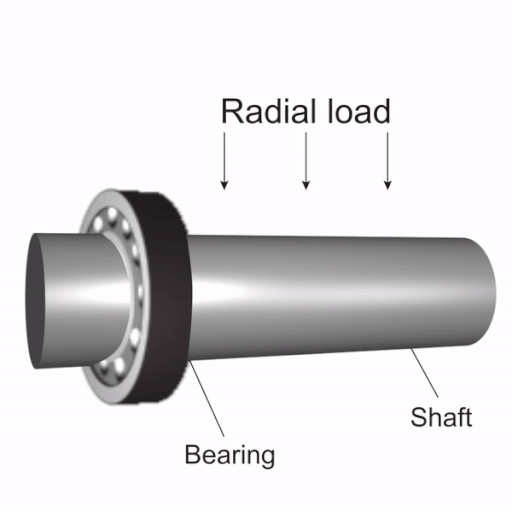Angular Contact vs Radial Bicycle Bearings: Understanding the Differences
Share
Angular Contact vs Radial Bicycle Bearings: Understanding the Differences 
Published: Monday, June 16th, 2025
When it comes to bicycle bearings, not all are created equal.You can have two bearings that look identical on the outside with the same size, materials and seals and, yet, they are entirely different and work in a completely different way.
This can be seen below.

Fig 1: Ball Bearings: Radial v Angular Contact
Both bearings look exactly the same; however, on the left, we have a 6902-2RS bearing and, on the right, we have a 7902-2RS bearing.
Looking back at last week's Blog posts on Bearing Codes, you know by reading the codes on the seals that they are two different types of bearing; 69** tells you that the left is a Deep Groove (Radial) Ball Bearing and the 79** tells you that the right bearing is an Angular Contact Ball Bearing.
If you removed either of these from your bike and couldn't read the seals, then you would measure the bearing and either assume that it was a 6902 bearing because they are more common or open up the bearing to check it's structure.
What Are Radial Bearings?
Radial bearings are designed to handle loads that are radial to the axis of the shaft i.e. perpendicular to the axle.

Key characteristics of radial bearings:
- Have a small contact angle of 8 degrees which helps reduce the stress caused by the load carried;
- Commonly used in wheel hubs, bottom brackets, and headsets
- Excellent for supporting the weight of the rider and bike
- Generally more affordable and widely available
What Are Angular Contact Bearings?
Angular contact bearings are engineered to handle both radial and axial loads simultaneously. The radial force shown above and the axial load shown below:-

The contact angle between the balls and race allows these bearings to manage forces coming from multiple directions.
Key characteristics of Angular Contact Bearings:
- Feature a contact angle (typically 15°, 25°, or 40°)
- Often used in pairs for optimal performance
- More complex design but superior load handling
Where You'll Find Each Type on Your Bike
Radial Bearings Are Common In:
- Standard wheel hubs
- Basic bottom bracket systems
- Some headset applications
- Pivot points
- Jockey wheels
Angular Contact Bearings Excel In:
- High-performance wheel hubs
- Precision headsets
- Bottom brackets under high stress
- Suspension pivot points (in some designs) e.g. a large percentage of Intense Cycles models use Angular Contact Bearings in their pivots.
Performance Differences That You Should Consider
Load Handling
Angular contact bearings win when your bike faces complex forces - think aggressive cornering, jumping, or steep descents where forces come from multiple directions.
Radial bearings perform excellently under straightforward vertical loads but can struggle with side forces.
Durability
For UK trail conditions with varied terrain and weather, angular contact bearings typically last longer in high-stress applications. However, radial bearings can be perfectly adequate for less demanding riding styles or can just be changed out more regularly.
Maintenance Requirements
Both bearing types benefit from regular maintenance, but angular contact bearings may require more precise adjustment, especially when used in pairs. Radial bearings are generally more forgiving of slight misalignment.
Cost Considerations
Radial bearings are typically more budget-friendly, making them ideal for:
- Casual riders
- Budget builds
- Frequently replaced components
Angular contact bearings represent a higher initial investment but offer:
- Extended service life in demanding applications
- Better performance under varied loads
- Reduced long-term replacement costs
Making the Right Choice for Your Riding
Choose radial bearings if:
- You're building on a budget
- Your riding is primarily on smooth trails
- You prefer simpler maintenance
- You're replacing bearings frequently anyway
Choose angular contact bearings if:
- You ride aggressively or competitively
- Your bike sees varied terrain and conditions
- You want maximum durability
- Performance is a priority over initial cost
UK Trail Considerations
British riding conditions - from muddy bridleways to rocky fell descents - often benefit from the superior load handling of angular contact bearings in critical areas like headsets and high-end hubs. However, for many UK riders, quality radial bearings provide excellent service at a more accessible price point.
The Bottom Line
Understanding Angular Contact Bearings vs Radial bearings helps you make informed decisions about your bike's performance and maintenance. While angular contact bearings offer superior performance in demanding applications, radial bearings remain an excellent choice for many cycling situations.
The key is matching the bearing type to your riding style, budget, and performance requirements. Whether you choose Angular or Radial, regular maintenance and quality bearings will keep your bike running smoothly on every ride.
Need help choosing the right bearings for your bike? Browse our range of frame bearing kits and individual bearings, or get in touch for personalised advice.
